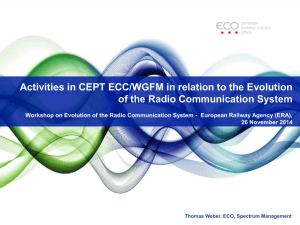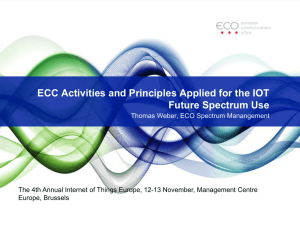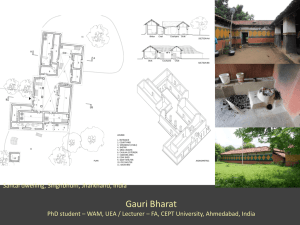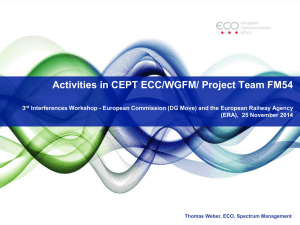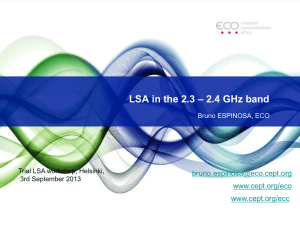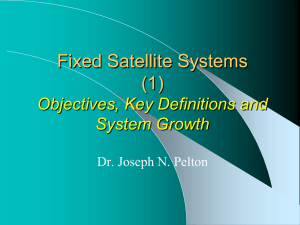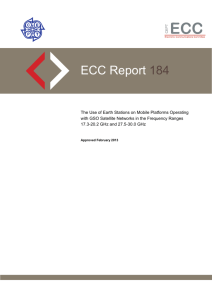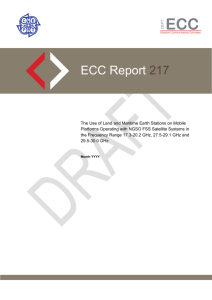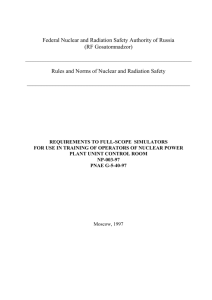Presentation CEPT View On ESOMPs
advertisement
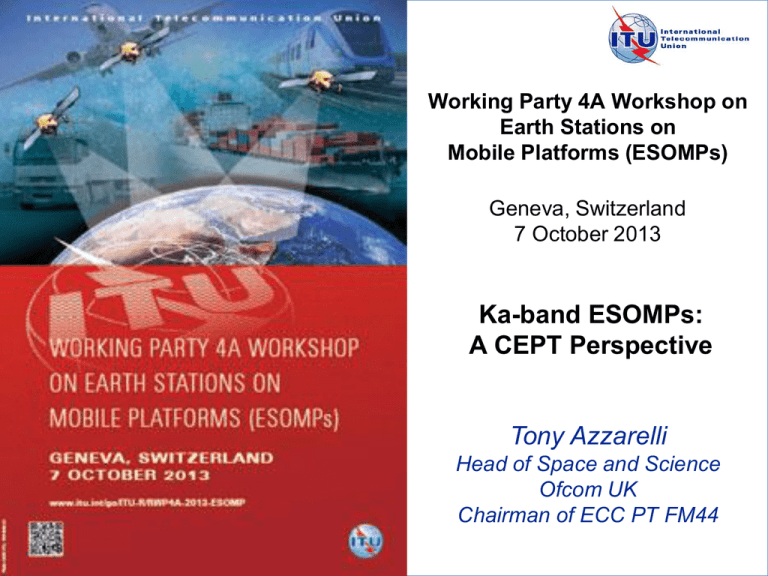
Working Party 4A Workshop on Earth Stations on Mobile Platforms (ESOMPs) Geneva, Switzerland 7 October 2013 Ka-band ESOMPs: A CEPT Perspective Tony Azzarelli Head of Space and Science Ofcom UK Chairman of ECC PT FM44 Ka-band ESOMPs: A CEPT Perspective WORKING PARTY 4A WORKSHOP ON EARTH STATIONS ON MOBILE PLATFORMS (ESOMPS) 7 OCTOBER 2013 Tony Azzarelli Chairman of CEPT ECC Project Team FM44 Head of Space and Science at Ofcom (UK) Summary CEPT perspective on ESOMPs: - ESOMPs are not consumer equipment; - ESOMPs’ benefits to consumers and business; - Ka-band provides for a natural place for ESOMPs; - ESOMPs are an FSS application; - Development and National Implementation of ECC DEC(13)01 and Report 184. Some terminology used: Ku-band FSS: 14.0-14.5 GHz / 10.7-12.75 GHz Ka-band FSS: 27.5-30.0 GHz / 17.3-20.2 GHz 2 1. Earth Station on-board Mobile Platforms (ESOMPs) ESOMPs are what the words say Earth Station On Mobile Platforms - they are basically Earth Stations: - use the Fixed Satellite Service infrastructures; - high data rate ( up-to 10 Mbps↑ // 50 Mbps↓); - directional antenna (30/40 dBi). - with the added value of being installed on moving platforms: - Land: on train, trucks ... ; - Aero: on aircraft, helicopter ... ; - Maritime: ships, oil rig .... - and from a regulatory perspective they can use both MSS or FSS bands: - CEPT has concluded that these platforms can be deployed in FSS bands. 3 ESOMPs: Land, Air and Sea ESOMPs expand the normal FSS and MSS type applications providing truly broadband services to mobile platforms AIR SEA LAND 4 2. Benefits for Business and Consumers - Benefits to Consumers ESOMPs are new platforms providing truly global satellite services, thus well apt for bandwidth hungry applications on the go: - for tablets, smart phones; - internet, social media, broadcasting, data transfer, ... - Benefits to Business In addition to provision of internet, broadcast and data services, they also provide bespoke applications on: - land: fleet management, M2M, and pipe for data hungry applications; - marine: oil platforms, research; - aero: airline non-safety communications, UAS; - government use: border control, search and rescue. 5 3. Ku-band regulatory experience What did we learn from Ku-band ESV and AES? - use of FSS platforms to deploy high data rate mobile technology - internet, TV, telephony - on board trains, aircraft and vessels - use of highly stabilised antennas - protect other services (FSS, FS) - use of harmonised regulatory provisions to protect other services - ETSI standards, ECC Decisions: e.g. pfd limits, aggregate OOB limits - require active and automatic control of transmissions - use of ECO notification measures - we know who deploys such systems Ku-band regulatory environment which allows deployment of professional mobile satellite equipment operating under FSS platforms resulted in an interference free environment. 6 4. Comparision Ku-band vs Ka-band technology Ka-band ESOMPs have: - Higher satellite performance - G/T, e.i.r.p. → small beams → higher spectral efficiency - Smaller equipment / antennas - lower weight and drag (and lower cost) - Higher spectrum availability - more available spectrum (2 x 2.5 GHz) and higher spectrum efficiency - Lower orbital congestion - Ku-band been exploited for 20/30 years now - Bespoke satellite systems - Global systems and 5x to 10x the data rate per channel - Higher protection to terrestrial services - higher terrestrial link margins and higher attenuation 7 5. Existing CEPT regulatory environment CEPT(48) promotes free circulation and license exemption for FSS and AES equipment in C1, Ku and Ka-band. - Land: Uncoordinated FSS, VSAT, LEST2, HEST3 - ECC/DEC(05)01, (05)08, (06)02, (06)03 & related ETSI standards. - Maritime: Earth Station on board Vessels (ESVs) - ECC/DEC(05)09 (C-band) & DEC(05)10 (Ku-band); - ETSI Harmonised Standard EN 301 447 & EN 302 340. - Aeronautical: Aircraft Earth Stations (AESs) - ECC/DEC(05)11 (Ku-band)2 & ETSI EN 302 186. EU(28) regulatory arena is based on a legally binding framework: - Framework /Authorisation Decisions → hands-off / light touch; - R&TTE Directive → presumption on compliance. 1 C-band: 3600-4200 / 5950-6425 MHz 2 Low e.i,r.p. Satellite Terminal, 3 High e.i.r.p Satellite Terminal 8 6. Adoption of a CEPT regulatory framework - ECC-Working Group Frequency Management (WGFM) - Project Team FM44 undertook to study ESOMPs in 2010 with the aim that (see ECC Report 184): “Any regulatory framework adopted in these bands to accommodate ESOMPs should also ensure that it does not prejudice the use of these bands by other FSS and terrestrial applications operating in conformance with other ECC Decisions.” 1 WRC03 outcome (see No. 5.516B). 2 ECC/DEC/(05)01 provides for nearly 1 GHz of FSS spectrum for uncoordinated FSS 9 7. ESOMPs are FSS CEPT decided that ESOMPs are an FSS application This based on: - the Ku-band experience, which shows that they are like-FSS; - the known FSS regulatory environment in Ka-band; - the need for CEPT to promote innovative technology through convergence and harmonised approaches for the benefit of all. ESOMPs that comply with ECC Decision and ETSI Standard can be considered as a typical uncoordinated FSS Earth station. ESOMPs can operate within the bands available for uncoordinated FSS earth stations, do not require individual license and can circulate freely in administrations implementing the applicable Decisions. 10 8. Developing ECC DEC(13)01 & REPORT 184 WGFM Sep/10 Work Item Ask to work on Assigned ESOMPs SE19 PT SE40 Starts Technical 2011-2012 Work Jan/11 Provides Technical conditions Mar/13 Draft Report PT FM44 Starts work on ESOMPs Dec/10 Request to start work on ESOMPs Jun/10 Report 184 TechnicalAug/12 conditions DEC(13)xx Draft Decision WGFM Feb/13 Publication Sep/12 Report 184 Public DEC(13)01 Consultation Oct-Nov 12 11 9. ECC Report 184 ECC Report 184 on GSO ESOMPs took three years to study/develop: - the technical and operational solutions - the regulatory framework; Concluded, inter-alia: - FSS limits - apply also to ESOMPs; - Land ESOMPs - as Uncoordinated FSS; - Aero and Maritime ESOMPs - pfd threshold - Use of 17.7-19.7 GHz band - non-protection - Network Control Facility (NCF) to ensure protection of other services. 12 9. ECC ECC DEC(13)01 ECC/DEC/(13)01 adopted 8 March 2013 - Decides 1 - Harmonises ESOMP use within 17.3-20.2 / 27.5-30.0 GHz; - Decides 2: for Administrations - designate frequencies for ESOMP use on a national basis; - provide information to the ECO (e.g. bands, airport operations); - allow free circulation and exempt from individual licensing; - Decides 3: provides for technical and operational conditions: - Annex 1: provides for ETSI standard, max EIRP, NCF, off-axis e.i.r.p, automatic self-monitoring, ceasing transmission; - Annex 2: provides for protection of other services e.g. PFD threshold; - Annex 3: provides for EMC protection to aircraft fields; - Annex 4: Operator’s notification form to submit to the ECO. 13 9. ESOMP must comply with R&TTE Directive ETSI Harmonised Standard EN 303 978 - For Manufacturers - Ensures an agreed regulated means to test lab their equipment; - Ensures quick deployment to market and inter-operability; - For Regulators - ETSI HS ensure an harmonised framework for equipment type approval (and CE marking under the EU R&TTE Directive); - Ensures that other in-band and out-of-band services are protected at any point in time and space; - For Service Providers - Ensures equipment compliance to regulations and health/safety; - Ensures quick to market access. 14 10. CEPT National Implementation CEPT(48) EN 303 978 DEC(13)01 National Implementation (full or partial) Report 184 Reference - Regulatory Analysis - Technical Analysis ESOMP - Free circulation - Equipment license exemption 15 11. Conclusion ESOMPs provide a truly broad-band experience on mobile platforms and on a global scale. CEPT confirmed that ESOMPs are treated as an FSS application provided that these protect existing services by complying with DEC(13)01 and EN 303 978. CEPT Administrations are now implementing DEC(13)01 into their national regulatory framework. 16 Tony Azzarelli Head of Space and Science Spectrum Policy Group Ofcom UK 17 acronyms CEPT ECC WG PT ETSI EN HS M2M European Conference of Postal and Telecommunications Administrations Electronic Communication Committee Working Group Project Team European Telecommunication Standards Institute European Norm (under ETSI) Harmonised Standard (under ETSI) Machine to Machine MSS FSS AES ESV Mobile Satellite Service Fixed Satellite Service Aircraft Earth Station Earth Station on board Vessels e.i.r.p. pfd effective isotropically radiated power power flux density 18

